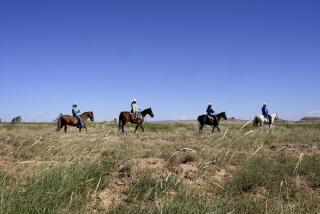Drums of Past : Tom-Toms, War Dances Provide Glimpse at the Culture and Ways of American Indians
- Share via
MISSION VIEJO — With eagle-feathered costumes, tom-toms and traditional war dances, a band of Navajo and Lakota Sioux brought a glimpse of Indian culture to Saddleback College on Wednesday for the campus’s first Native American Awareness Day.
From 9 a.m. to 3 p.m. on the upper quad, Saddleback’s diverse student body could browse through displays filled with Indian handicrafts, trace tribal ancestors or sample fry bread--the Indian equivalent of a tortilla--for $1.
“This was the one I’m most interested in,” David Brandt, a student from Mission Viejo, said of the school’s extracurricular programs. “It has to do with our area, and the culture is pretty much all gone, so it’s good to see what it was.”
Native American Awareness Day was organized by one of Prof. Mike Merrifield’s anthropology classes to combat stereotypes, promote cultural understanding and raise money to found a school club for those interested in American Indians.
With upwards of 10 booths displaying crafts, food and genealogical services, the daylong event drew about 200 people, one of the largest crowds for a school event at Saddleback.
“They don’t get this many people at football games,” said Mickey McGuire, a student in Merrifield’s North American Indians course. Through the class, McGuire, an Irvine film producer, learned that his grandfather was an Indian.
Merrifield said that his students were skeptical at first about putting on such an elaborate program in five weeks’ time but that when they became motivated, things fell into place.
“Once we showed interest in Indian culture, people really responded,” said Paul Evans, another student who ended up going to powwows in the area and recruited craftspeople and performers to attend the Saddleback event.
The centerpiece of Wednesday’s program was the Eagle Spirit Dancers from Downey, a troupe of Navajo and Lakota Sioux Indians. When the drums started and a dancer swooped in circles, all eyes on the school’s upper quad turned to the group and their costumes adorned with bells, eagle feathers, and bone.
Ben Hale, director of Eagle Spirit’s six dancers and two drummers, explained the symbolism and cultural significance of the dances which have been passed from generation to generation for thousands of years.
Introducing a war dance choreographed by Plains Indians before the horse came to North America, Hale said: “At that time we didn’t have a store down the street where we could go buy meat--you had to hunt buffalo! Plains Indians were fierce and tough because they had to be.”
A women’s war dance performed by the group illustrated that females were especially valued because they were thought to be closer to Mother Earth, Hale explained. He added that the elaborately feathered costumes used for an eagle dance showed that “Indians were experienced at using what was around them in their environment.”
Hale told the spectators that there are still more than 400 Indian tribes in the United States, each with its own language and culture. But to his dismay, he said, “they’ve gotten all lumped together.”
But Hale said a new generation of American Indians appears to be coming up through the educational system and will be able to help protect Indians’ rights and culture.
According to a district spokeswoman, there were about 280 American Indians registered at Saddleback College as of last fall, out of a total student body of 22,320.
“South Orange County has a real limited consciousness, and we hope to raise awareness that we have a large Native American community down here,” said Reece Foxen, another anthropology student who took Merrifield’s class to learn more about her children’s heritage. Foxen’s husband is an American Indian.
Finally, the troupe invited the audience to join its members in a circular friendship dance, and Hale closed the event with a prayer. “Thank you for letting me be born an Indian,” he said. “I am honored to be a United States citizen, but I am an Indian first.”
More to Read
Sign up for Essential California
The most important California stories and recommendations in your inbox every morning.
You may occasionally receive promotional content from the Los Angeles Times.










